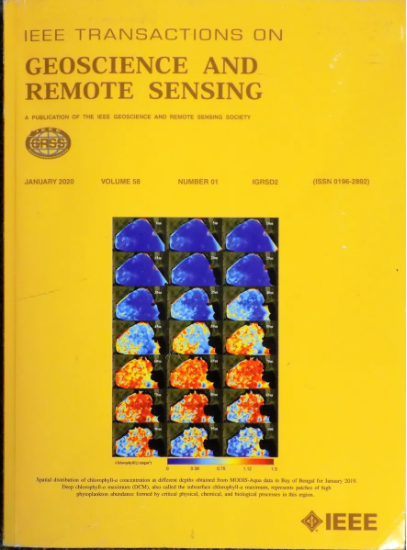基于参考图像引导像素聚类的高光谱图像强度自适应去条纹方法
IF 8.6
1区 地球科学
Q1 ENGINEERING, ELECTRICAL & ELECTRONIC
IEEE Transactions on Geoscience and Remote Sensing
Pub Date : 2025-01-20
DOI:10.1109/TGRS.2025.3531941
引用次数: 0
摘要
高光谱图像在地球科学、环境监测和资源管理等领域有着广泛的应用。但在实际工程应用中,hsi中的随机条纹噪声严重影响了数据质量和精度,影响了hsi的后续使用。在本文中,我们提出了一种基于参考图像引导像素聚类的HSI强度自适应去条纹方法。该方法通过三个主要阶段去除条纹噪声。首先,分析HSI以手动选择具有最小随机条纹噪声影响的特定波段图像。该图像被指定为初始参考图像,并确定其具体位置。其次,将提出的像素阈值分类方法深度最大类间方差(deep maximum interclass variance, DMIV)用于与参考图像相邻且受随机条纹噪声污染的带图像的像素阈值分类。最后,根据噪声强度将得到的像素分为两类:高强度(HIN)和低强度(LIN)。提出的灰度值强度自适应重建算法用于去除每个像素类别中的条纹噪声,并将去噪后的图像更新为新的参考图像。从初始参考图像开始,沿着光谱重复这些步骤,以实现所有波段的去条纹。我们使用真实的hsi将所提出的方法与传统和深度学习方法进行了比较。实验结果表明,采用该方法对图像进行去噪后,视觉质量和定量评价指标均有显著提高,对于灰度变化较大的hsi图像,去除条纹的效果尤为突出。本文章由计算机程序翻译,如有差异,请以英文原文为准。
Hyperspectral Image Intensity Adaptive Destriping Method Based on Reference Image-Guided Pixel Clustering
Hyperspectral images (HSIs) have widespread applications in geoscience, environmental monitoring, and resource management. However, in practical engineering applications, random stripe noise in HSIs severely affects data quality and accuracy, impacting the subsequent use of HSIs. In this article, we propose an HSI intensity adaptive destriping method based on reference image-guided pixel clustering. The proposed method removes stripe noise through three main stages. First, the HSI is analyzed to manually select a specific band image with minimal impact from random stripe noise. This image is designated the initial reference image, and its specific location is identified. Second, the proposed pixel threshold classification method, deep maximum interclass variance (DMIV), is used for pixel threshold classification for band images that are contaminated with random stripe noise and adjacent to the reference image. Finally, the resulting pixels are classified into two categories according to noise intensity: high intensity (HIN) and low intensity (LIN). The proposed intensity adaptive grayscale value reconstruction algorithm is used to remove stripe noise from each pixel category, and the denoised image is updated as a new reference image. Starting from the initial reference image, these steps are repeated along the spectrum to achieve destriping of all bands. We compare the proposed method against traditional and deep learning methods using real HSIs. The experimental results show that after denoising of the image using our method, both visual quality and quantitative evaluation metrics are significantly improved, with particularly excellent stripe removal performance observed for HSIs with significant grayscale variation.
求助全文
通过发布文献求助,成功后即可免费获取论文全文。
去求助
来源期刊

IEEE Transactions on Geoscience and Remote Sensing
工程技术-地球化学与地球物理
CiteScore
11.50
自引率
28.00%
发文量
1912
审稿时长
4.0 months
期刊介绍:
IEEE Transactions on Geoscience and Remote Sensing (TGRS) is a monthly publication that focuses on the theory, concepts, and techniques of science and engineering as applied to sensing the land, oceans, atmosphere, and space; and the processing, interpretation, and dissemination of this information.
 求助内容:
求助内容: 应助结果提醒方式:
应助结果提醒方式:


